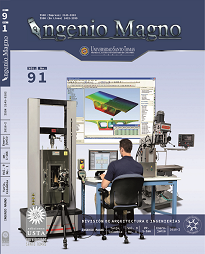Plano para o adequado manuseio de sedimentos, que permite aumentar a vida útil da barragem a esmeralda
##plugins.themes.bootstrap3.article.main##
Resumo
Downloads
##plugins.themes.bootstrap3.article.details##
DECLARACIÓN DE ORIGINALIDAD DE ARTÍCULO PRESENTADO
Por medio del presente documento, certifico(amos) que el artículo que se presenta para posible publicación en la revista institucional INGENIO MAGNO del Centro de Investigaciones de Ingeniería Alberto Magno CIIAM de la Universidad Santo Tomás, seccional Tunja, es de mi (nuestra) entera autoría, siendo su contenido producto de mi (nuestra) directa contribución intelectual y aporte al conocimiento.
Todos los datos y referencias a publicaciones hechas están debidamente identificados con su respectiva nota bibliográfica y en las citas que se destacan como tal. De requerir alguna clase de ajuste o corrección, comunicaré(emos) de tal procedimiento con antelación a los responsables de la revista.
Por lo anteriormente expresado, declaro(amos) que el material presentado en su totalidad se encuentra conforme a la legislación aplicable en materia de propiedad intelectual e industrial de ser el caso, y por lo tanto, me(nos) hago (hacemos) absolutamente responsable(s) de cualquier reclamación relacionada a esta.
En caso que el artículo presentado sea publicado, manifiesto(amos) que cedo(emos) plenamente a la Universidad Santo Tomás, seccional Tunja, los derechos de reproducción del mismo.
Referências
Sánchez, C., & Fuquen, H. (2013). SEDIMENTOS: UNO DE LOS RETOS DE LA GENERACIÓN HIDROELÉCTRICA. DESARROLLO TECNOLÓGICO E INNOVACIÓN EMPRESARIAL, 6-8. Obtenido de http://www.colinnovacion.com/wpcontent/uploads/ARTICULO-2EDICI%C3%93N-2-VOLUMEN-1-JUNIO2013.pdf
Diagnóstico Gestión de Sedimentos CNO - ACOLGEN noviembre 2016.
ANEEL Agencia Nacional de Energia Electrica de Brasil, 2000. Reservoir Sedimentation Assesment Guideline, Brasilia: Hydrologic Studies and Information Department.
GML Engineering COOP, 2012. Sedimentos en el Embalse La Esmeralda, Bogotá: s.n.
Reservoir . Morris, G. & Fan, J., 1998. Sedimentation Handbook, Nueva York: McGraw-Hill.
Evacuation of sediments . White, R., 2001. from reservoirs, Londres: Thomas Telford.
World Bank, 2003. Reservoir conservation : economic and engineering evaluation of alternative strategies for managing sedimentation in storage (Vol1), Washington D.C.: World Bank.
Rojo Hernández, Julián David and Carvajal Serna, Luis Fernando (2010) ), Predicción no lineal de Caudales utilizando variables Macro-climaticas y analisis espectral singular. Tecnología y Ciencias del Agua, antes Ingeniería hidráulica en México, vol. I, núm. 4, octubre-diciembre de 2010, pp. 5973 0186-4076 ISSN:
Rojo Hernández, Julián David (2016) Modelo de pronóstico de aportes diarios utilizado en la PCH Tunjita In: V Jornada Técnica de Hidrología - CNO, 09 de noviembre de 2016, Bogotá - Colombia.

